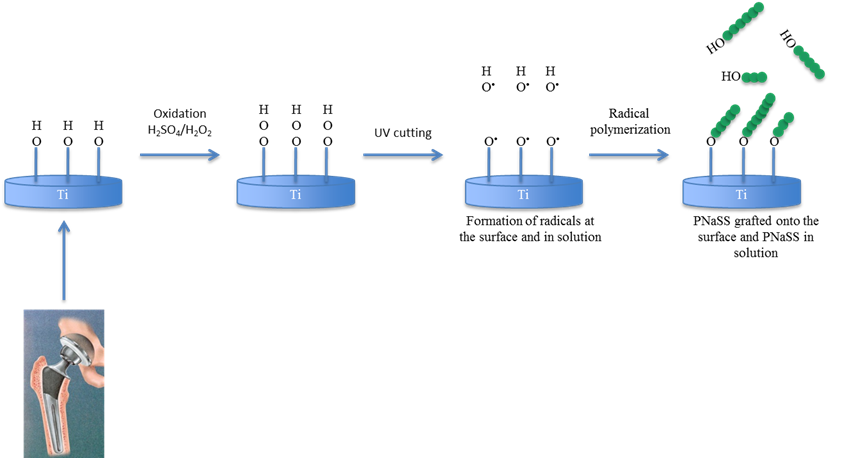Introduction: Titanium is widely used in orthopedic implants for its excellent resistance to corrosion and its biocompatibility. Nevertheless and despite the prevention rules, 1.5 to 2 % of implanted prostheses are still subject to bacterial infections, threatening their benefit on a long-term basis. That’s the reason why chemical modification of titanium surfaces to confer desirable functional properties is required. In order to prevent bacteria and improve the long-term osteointegration of titanium, bioactive polymers bearing ionic groups (sulfonate) were covalently grafted onto titanium surfaces. Classically, the grafting used the heat to create radicals and lasted more than half day[1]-[6]. We have elaborated a new approach to create radicals (UVs) in only one hour[7].
Methods: Grafting procedure (Figure 1): Titanium surface were cleaned by successive 10 min ultrasound treatments in a bath of distilled water. After drying, samples were oxidized in a solution containing the same volume of pure H2SO4 and H2O2 (30%). After oxidation, samples were rinsed thoroughly in distilled water and then placed directly into a mechanically stirred solution of the monomers. After UV initiation of the radical polymerization, samples were rinsed thoroughly in distilled water and dried.
Results and Discussion: Ionic groups (sulfonate) were covalently attached to the titanium surfaces by radical polymerization of sodium styrene sulfonate (NaSS) initiated by radicals issued from titanium peroxide. Immersion of titanium samples in a mixture of pure sulphuric acid and hydrogen peroxide produces on its surface titanium hydroxide and titanium peroxide. The decomposition of titanium peroxide in radicals was been produced by UV irradiations. Amounts of grafted polymers were measured by colorimetric method. Other techniques were used to check the presence of the bioactive polymers at the surface of titanium samples: XPS analysis, IR-ATR, Contact angle analysis. The grafting by UV way showed same results than thermal way, yet the UV way is the fastest (15 times faster).
Conclusion: In the last decade, many studies have been devoted to improving the bone cell-implant interaction, with the goal of improving the osseointegration of devices for dental and orthopaedic applications. There are various ways to modify surface implants, and our strategy is to graft polymer model at their surface in using the UVs. The advantage of our method is that the coating is linked by a covalent bond to the titanium substrates. Surface characterization techniques have shown that the UV grafting of bioactive polymers at the surface of titanium reaches 5 µg.cm-2 like by thermal grafting. Our approach is interesting from an industrial point of view because it also needs few time and few quantity of monomers to obtain a high yield of polymer grafting. Excellent biological results were been obtained by thermal grafting and we would like to check biologically the UV grafting.

Figure 1: Grafting of bioactive polymers on titanium surfaces.
References:
[1] H. Felguerias et al., IRBM, 34 : 371-375, 2013.
[2] H. Felguerias et al., Langmuir, 30: 9477-9483, 2014.
[3] G. Hélary et al., Journal of Materials Science - Materials in Medicine, 21: 655-663, 2010.
[4] G. Hélary et al., Acta Biomaterialia, 5: 124-133, 2009.
[5] V. Migonney., Patent FR N° WO/2007/141460, 2006.
[6] D. M. Vasconselos et al. Materials Science and Engineering C, 45:176-183, 2014.
[7] C. Falentin-Daudré, V. Migonney, H. Chouirfa, J-S. Baumann, Patent FR 15/57621, 2015.